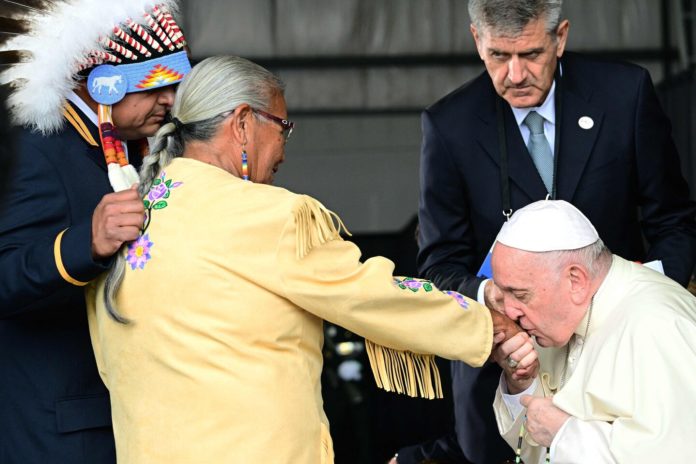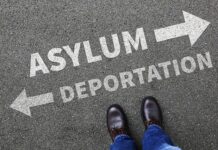
Francis’s visit is the result of years of Indigenous requests for an official acknowledgment from the church. Though Francis for much of his pontificate had demurred, he had faced mounting pressure after Indigenous groups last year said ground-penetrating radar had located hundreds of unmarked graves near former residential schools.
The trip is a major break from the norms of papal overseas travel, where celebration and evangelization tend to be the central goals. In this instance, Francis, 85, opted only for a modest welcome ceremony when landing Sunday in Edmonton, where he was greeted with Indigenous music, and he has chosen not to issue any remarks until arriving Monday morning in Maskwacis, an Indigenous community in the plains of Alberta.
Though the residential schooling system is no longer in use, with the last schools closing in the 1990s, the colonizing ideas that underpinned it remain sources of reckoning in the modern Roman Catholic Church. Francis, the first South American pope, comes from a continent where Christianity was brought by conquerors. During a 2015 trip to Bolivia, he apologized for the church’s “grave sins” during colonialism and for crimes committed against native people.
In Canada, at least 150,000 Indigenous children were forced into the residential school system, which was notorious for poor conditions. Malnutrition was rampant, as was physical and sexual abuse, and children died at rates several times above the national norm.
The Truth and Reconciliation Commission, in 2015 a landmark report, called it “institutionalized child neglect.” The Catholic Church ran a majority of the schools; others were run by Anglicans, Presbyterians and the United Church. The report said the schools played to the idea of bringing “civilization and salvation” to children.
“These were the rationales that were used to justify making the lives of so many children so unhappy,” the report said.
Francis, after hosting an Indigenous delegation at the Vatican, apologized in April for the “deplorable conduct” of some “members” of the Catholic Church involved with the residential school system. But some survivors say those words did not go far enough, and they hope that Francis will address the complicity of the Catholic Church. They also have urged him to pledge the release of records related to residential schools, and for the return of artifacts from the Vatican museum.
At Francis’s first stop Monday, he is expected to speak in front of several thousand people, many of them survivors of the residential school system. He will also pray at cemetery grounds believed to include the remains of residential school students, and he will visit the former site of the Ermineskin residential school, which opened in 1895 and was operated by Roman Catholic missionaries for much of its existence. It was taken under federal control in 1969 and closed in 1970.
In testimony before the Truth and Reconciliation Commission, former students from that school painted a picture of days marked by loneliness, fear and abuse. One said she was told that the Sun Dance, an Indigenous ceremony, amounted to devil worship.
Marilyn Buffalo told the commission that teachers called the children “savage.”
Overcrowding and outbreaks of diseases, including measles, hepatitis and diphtheria were common. A 1940s survey found that one-third of the students had tuberculosis and suggested students be sent to the hospital. Instead, some were sent home and others were kept under observation.
In 1966, a supervisor at the school wrote the federal department of Indian Affairs chief superintendent of education to report that priests were whipping girls with straps on their “bare bottoms.” She included the testimony of two students. She was dismissed.
At least 15 children died or went missing at the Ermineskin school, according to the National Center for Truth and Reconciliation, in the course of its history.
Victor Buffalo was 7 years old when he was sent to the Ermineskin school and spoke no English. He told The Washington Post that school administrators withheld food as punishment and whipped him frequently for speaking his native Cree.
After one such beating in front of his friends, Buffalo, the former chief of the Samson Cree Nation in Alberta, retreated to a nearby bathroom to cry — not because he was in physical pain, he said, but because his mother and father weren’t there to care for him.
Buffalo said that his relationship with his parents, who also attended residential schools, was strained for many decades after he left the school in 1961. Severing ties to Indigenous culture, including familial ones, was an aim of the system.
“The greatest thing that we lost was love,” said Buffalo, who will be present when Francis visits Maskwacis. “The love of a family, the love of a mother, the love of a father.”







